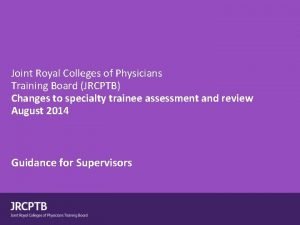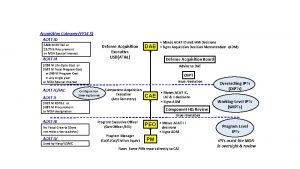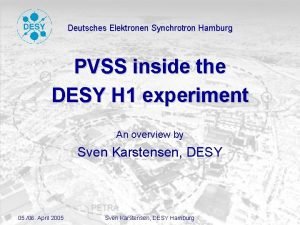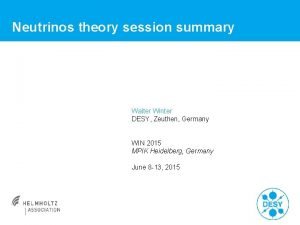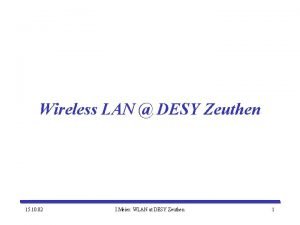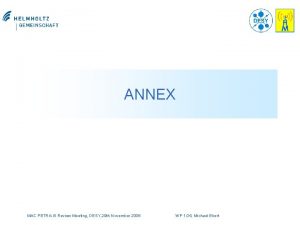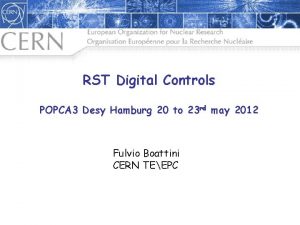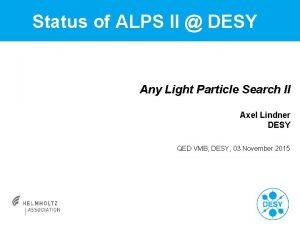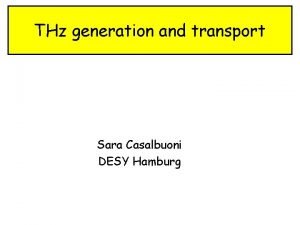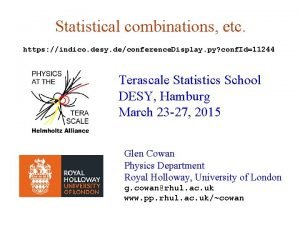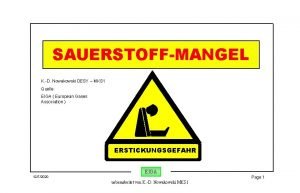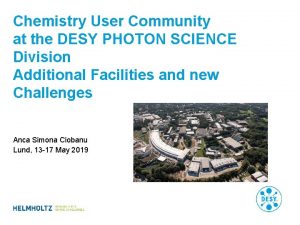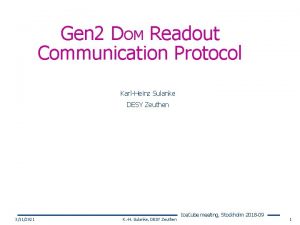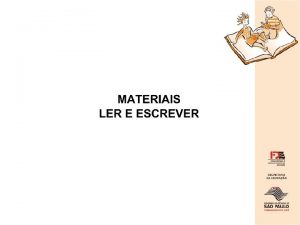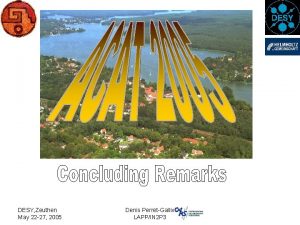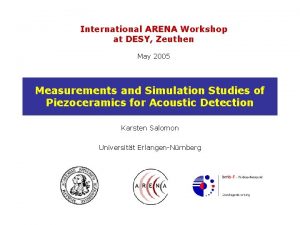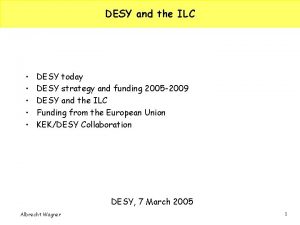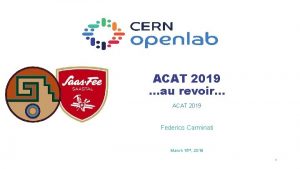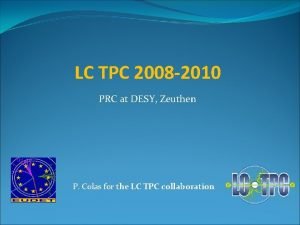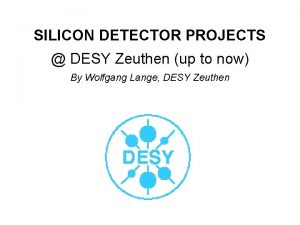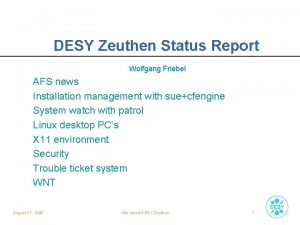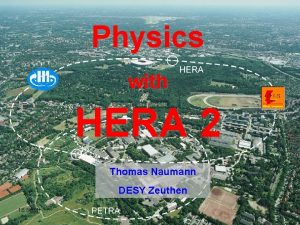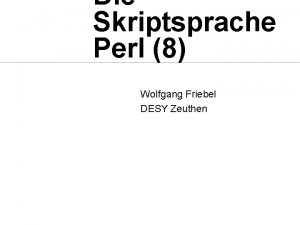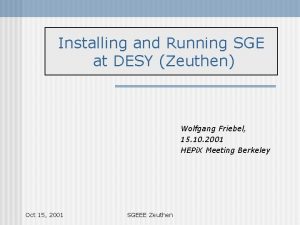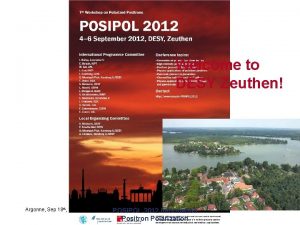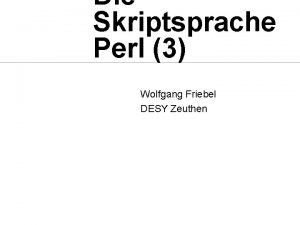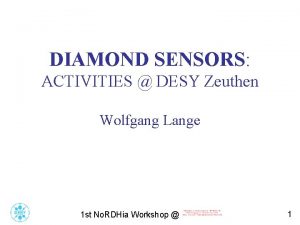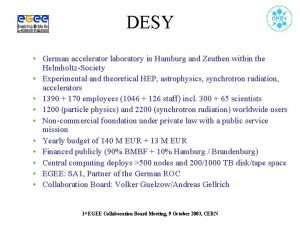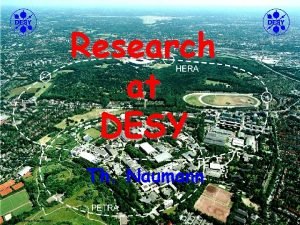ACAT 05 May 22 27 2005 DESY Zeuthen























- Slides: 23

ACAT 05 May 22 - 27, 2005 DESY, Zeuthen, Germany The use of Clustering Techniques for the Classification of High Energy Physics Data Mostafa MJAHED Ecole Royale de l’Air, Mathematics and Systems Dept. Marrakech, Morocco

The use of Clustering Techniques for the Classification of High Energy Physics Data · Production of jets in e +e · Methodology · The use of Clustering Techniques for the Classification of physics processes in e+e- · Conclusion M. Mjahed ACAT 05, DESY, Zeuthen, 25 May 2005 2

Production of jets in e +e e+e - W +W-, ZZ, ZH (H: Higgs) (LEP 2 and beyond) */ Z 0 qq , H 0 qq …) W+ q 1 q 2 , W q 3 q 4 - Jet of hadrons Perturbative Region ·Annihilation ·Decay of produced bosons: - W+ e+ e. W- ·Fragmentation of quarks and gluons and production of unstable particles ·Decay of unstable particles to observed hadrons Decay of unstable particles Jet of hadrons Confinement Region Fragmentation of quarks and gluons

Production of jets in e +e - LEP 2, observation of processes with dominants jets topologies: · Production of pairs W +W - : e+e- W +W - qql l , qqqq · Emergence of new particles as the Higgs Boson: e+e- ZH qqbb, bb ( + -qq , qq + -) · Production of new processes: e+e- ZZ qq l l , qqqq, . . . M. Mjahed ACAT 05, DESY, Zeuthen, 25 May 2005 4

Higgs boson Production Higgs-strahlung: e+ e- ZH Fusion WW Decay Modes: · decay into quarks: H bb and H cc · leptonic decay H + · gluonic decay H gg · decay into virtual W boson pair: H W +W - • Cross Section • Branching Ratio

Production of jets in e +e - • HZ ALEPH candidate e+ e- H Z qqbb M. Mjahed ACAT 05, DESY, Zeuthen, 25 May 2005 6

Jets analysis in e+ e- · Analysis of W bosons pairs and research of new particles as the Higgs boson. · Measure of the masse of W · Measure of the Triple Gauge Coupling (TGC); coupling between 3 bosons Prediction of limits concerning the mass of the Higgs boson · These analyses are subjected to the identification of the different processes, with dominant jets topologies with a very high efficiency · Need to use Pattern Recognition methods

Pattern Recognition f: X Y xi X yj Y • Characterisation of events: research and selection of p variables or • Interpretation: definition of k classes • • Learning: association ( xi yj ) f attributes Decision ( xi yj ) using f for any xi M. Mjahed ACAT 05, DESY, Zeuthen, 25 May 2005 8

Pattern Recognition Methods • • • M. Mjahed Statistical Methods • • Principal Components Analysis PCA Decision Trees Discriminant Analysis … Clustering (Hierarchical, K-means, …) Connectionist Methods • • Neural Networks Genetic Algorithms … Other Methods • Fuzzy Logic, Wavelets. . . ACAT 05, DESY, Zeuthen, 25 May 2005 9

Hierarchical Clustering Technique C C 2 C 1 D C 3 C 7 C 8 C 7 C 4 C 5 . . . C 6. . . · 1. The distances between all the pairs of events xi and xj are computed • 2. Choice of the two most distant events: C (C 1 , C 2 ) • 3. Assignation of all xi to the closer class C 1 or C 2 • 4. Repeat the steps 2 and 3 for C 1 (C 3 , C 4 ) and C 2 • 5. Repeat the step 4 for Ci (xj , xk ) (C 5 , C 6) . . .

K-Means Clustering Technique Given K, the K-means algorithm is implemented in 4 steps: · Partition events into K non empty subsets · Compute seed points as the centroids (mean point) of the cluster · Assign each event to the cluster with the nearest seed point · Go back to step 2, stop when no more new assignment • Parameters: • Choice of distances • Supervised or unsupervised Learning M. Mjahed ACAT 05, DESY, Zeuthen, 25 May 2005 11

Clustering by a Peano Scanning Technique Example of an analytical Peano square-filling curve · Decomposition of data into p-dimensional unit hyper-cube Ip = [0, 1] … [0, 1] · Construction of a Space Filling Curve (SFC) Fp (t): I 1 Ip · Compute the position of X (data) on the SFC, i. e. , t = (x) · Find the set K of nearest neighbours of t in the transformed learning set T · Classify the test sample to the nearest class in set K

Efficiency and Purity of a Pattern Recognition Method • Validation Test events · Efficiency of classification for events of class Ci M. Mjahed · Purity of classification for events of class Ci ACAT 05, DESY, Zeuthen, 25 May 2005 13

Application 4 jets e+ e- HZ bbqq e+e- W+W- qqqq e+e- ZZ qqqq e+ e- /Z qqqq · Characterisation of the Higgs boson in the 4 jets channel, e+e- ZH qqbb , by clustering techniques M. Mjahed ACAT 05, DESY, Zeuthen, 25 May 2005 14

Characterisation of the Higgs boson in 4 jets channel e+ e- ZH qqbb by the use of clustering techniques 4 jets event HZ event · Background /Z, W+W -, ZZ · Events generated by the LUND MC (JETSET 7. 4 and PYTHIA 5. 7) at s = 300 Ge. V, in the 4 jets channel · e+ e- HZ qqbb (signal: Higgs boson events), MH = 125 Ge. V/c 2 · e+e- W +W - qqqq, e+ e- Z/ qqgg, qqqq , e+ e- ZZ qqqq (Background events) Research of discriminating variables characterising the presence of b quarks

Variables · Thrust · Mincos: Min (cos ij + cos kl ): The minimal sum of cosines by using all the permutations ijkl. · Sphericity S · Max (Mjet), Max (Ejet): · Boosted Aplanarity: BAP maximal value of the jet masses and jet energies in each event · Mmin , Emin : · Max 3 (Mjet), Max 3 (Ejet): the 3 th value of the jet masses and jet energies in each event · Bed: Event broadening Bed = Min Bhemi the 4 th value of the jet masses and jet energies in each event · Rapidity-impulsion weighted Moments Mnm : i rapidity: the

Discriminating Power of variables · Test Function Fj , j=1, …, 17. Ø Bj , Wj: Between and Within-classes Variance Matrix for variable j. Ø n total number of events (signal+ background), Ø k number of classes (2) · The discriminating power of each variable Vj is proportional to the values of Fj (j=1, …, 17).

Hierarchical Clustering Classification · The most separating distance DHZ/Back between the C classes CHZ and CBack is searched and the corresponding cut DHZ/Back * is computed. · The classification of a test event x 0 is then obtained according to the algorithm: CHZ CBack if DHZ/Back (xo) DHZ/Back* then xo CHZ else xo CBack · DHZ/Back = 0. 01 Mincos +0. 32 Max. E + 0. 11 Max 3 E + 0. 52 Emin + 0. 36 BAP + 0. 87 Bed + 0. 41 M 11 + 0. 38 M 31 · DHZ/Back* = 2. 51 · Classification of test events

K-Means Clustering Classification For K=2, the K-means algorithm is implemented in 4 steps: C · Partition events into 2 non empty subsets · Compute seed points as the centroids (mean point) of the cluster · Assign each event to the cluster with the nearest seed point · Go back to step 2, stop when no more new assignment · Classification of test events CHZ CBack

Peano space filling curve Clustering Classification · By using the training sample: X = (xi (M 11, M 21, M 31 , M 41, M 51 , M 61, T, S, BAP, Bed, Mincos, Max. E, Max. M, Max 3 E, Max 3 M, Emin, Mmin), i=1, …, N=4000) and the known class labels: CHZ, Cback an approximate Peano space filling curve is obtained, allowing to transform the 17 -dimensional space into unit interval. · Classification of test events

COMPARISON · Comparison between the 3 clustering methods · Purity of classification vs cut’s values D* in hierarchical clustering DHZ/Back = 0. 01 Mincos +0. 32 Max. E + 0. 11 Max 3 E +. 52 Emin + 0. 36 BAP + 0. 87 Bed + 0. 41 M 11 + 0. 38 M 31 DHZ/Back* = 2. 51 DHZ/Back* = [1. 65, 1. 75, …, 2. 51, …, 2. 65, …]. Purity(%) = [50, 51, 52, …, 80] Hierarchical Clustering

Conclusion 4 jets · Variables e+e- HZ e+e- ZZ e+e- WW e+e- /Z · Characterisation of Higgs Boson events: The most discriminating variables are: Mincos, Max. E, Max 3 E, Emin, BAP, Bed. They show the importance of information allowing to separate between b quark and udsc-quarks (separation between HZ events and background: H bb ). · Other variables as Emin, Mmin, BAP, Bed, Mincos, may be used to identify events emerging from the background (i. e. e+e- Z / 4 jets). · Discrimination ( /Z ) / WW / ZZ: using dijets properties: charge, broadness, presence of b quarks. . .

·Methods · · Conclusion (continued) Importance of Pattern Recognition Methods The improvement of an any identification is subjected to the multiplication of multidimensional effect offered by PR methods and the discriminating power of the proposed variable. · The hierarchical clustering method is more efficient than the other clustering techniques: its performances are in average 1 to 3 % higher than those obtained with the two other methods. · · Other cut's values DHZ/Back* give other efficiencies and purities: We can reach values of purity permitting to identify the HZ events more efficiently Clustering techniques: comparative to other statistical methods : Discriminant Analysis, Decision trees, . . . · Clustering techniques: less effective than neural networks and non linear discriminant analysis methods
 Non acat vs acat
Non acat vs acat Jrcptb
Jrcptb Acat id
Acat id @olivia:kalkulator imt
@olivia:kalkulator imt Acat roma
Acat roma Desy wap
Desy wap Bf desy
Bf desy Walter winter desy
Walter winter desy Vpn desy
Vpn desy Michael ebert desy
Michael ebert desy Desy summer student program
Desy summer student program 3desy
3desy Alps desy
Alps desy Desy transport
Desy transport Desy hostel
Desy hostel Desy summer student
Desy summer student Indico desy
Indico desy Desy itt
Desy itt Desy photon science
Desy photon science Desy sax
Desy sax Hci patterns may or may not include code for implementation
Hci patterns may or may not include code for implementation 5 stages of counseling
5 stages of counseling Dessler 2005
Dessler 2005 Saresp 2005
Saresp 2005

